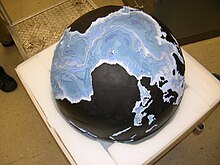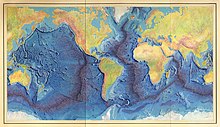Marie Tharp


Marie Tharp (born July 30, 1920 in Ypsilanti, Michigan , † August 23, 2006 in Nyack ) was an American geologist and cartographer . Her special achievement (together with Bruce C. Heezen ) consists primarily in the discovery of the rift in the mid-Atlantic ridge in 1952 and the later mapping of the other mid-ocean ridges , which was of great importance for the further development and confirmation of the theories of continental drift and plate tectonics .
Early life
Marie Tharp was born to Bertha Louise Tharp, a German and Latin teacher, and William Edgar Tharp, a soil surveyor for the US Department of Agriculture . Marie often helped him with this task, which gave her an early introduction to map making. Due to the nature of William Tharp's work, the Tharp family moved constantly until he retired in 1931. At this point, Marie had attended over 20 public schools in Alabama , Iowa , Michigan, and Indiana . A whole school year in Florence was particularly influential for Marie. There she attended a class called Current Science, which taught contemporary scientists and their research projects . She also had the opportunity to go on school trips on weekends to study trees and rocks. After his father retired, the family moved to a farm in Bellefontaine , Ohio, where Tharp graduated from high school.
Education and professional career
Influenced by her mother, a teacher, she took a year off before going to college; after graduating, she also planned to become a teacher. However, Tharp stayed on the farm to help after her mother's death in 1936 and did not enroll in college until 1939. On her father's advice, she chose a subject that she not only loved, but that would also offer her a career and financial security. In 1943 Tharp graduated from the University of Ohio with a bachelor's degree in English and Music. After the Japanese army's attack on Pearl Harbor , many young men dropped out of schools and universities to serve in the armed forces. Thus, the Second World War increasingly enabled women to take up jobs in areas such as geology , which until then had largely been reserved for men. Tharp studied geology at the University of Michigan , where she earned a master's degree .
Tharp still received during the war, a job at an oil company and worked from 1948 at the Lamont-Doherty Earth Observatory of Columbia University . From 1950 she worked together with Bruce C. Heezen on the mapping of the seabeds , which until now were largely unexplored. For this purpose, measurements had to be made from ships. However, these were often imprecise and so much was deduced from secondary data and previous geological knowledge. Marie Tharp did this so exceptionally well - and her maps were so confirmed by later satellite images - that the Library of Congress counts her among the four most important cartographers of the 20th century.
Together with Heezen she discovered the rift in the Mid-Atlantic Ridge in 1952 and later mapped the other mid-ocean ridges , which was of great importance for the further development and confirmation of the theories of continental drift and plate tectonics. Marie Tharp's map can be integrated and displayed in version 5 of the Google Earth program . The Library of Congress shows them in relatively high resolution.
In addition, Tharp published various scientific writings. Her main work The Floors Of The Oceans, V1: The North Atlantic (together with Heezen) was first published in the United States in 1959 and received an ISBN 978-1258423650 from its reprint in 2012 .
Personal
In 1948 she married David Flanagan and moved with him to New York, in 1952 they were divorced.
Tharp died of cancer on August 23, 2006 at the age of 86 in Nyack, New York.
honors and awards
Tharp has given its name to the Tharp Ice Rise in Antarctica since 1977 .
In 1996 she received the Outstanding Achievement Award from the Society of Woman Geographers for expertise in cartography and oceanography and for discovering the Rift Valley of the Mid-Atlantic Ridge .
The Lamont-Doherty Earth Observatory (LDEO) research institute launched the Marie Tharp Visiting Fellowship Program in 2004.
In 2013, the Helmholtz Center in Kiel initiated the Marie Tharp Lecture Series for Ocean Research (MTLS).
On March 30, 2015, the moon crater Tharp was named after the scientist.
Literature (selection)
- Jess Keating: Ocean Speaks: How Marie Tharp Revealed the Ocean's Biggest Secret, Tundra Books, 2020, ISBN 978-0735265080
- Hali Felt: Soundings: The Story of the Remarkable Woman Who Mapped the Ocean Floor, Picador, 2013, ISBN 978-1250031457
Web links
- Marie Tharp . "C250 Celebrates" from Columbia University, 2004 (English)
- https://www. britica.com/biography/Marie-Tharp
Individual evidence
- ↑ a b c Marie Tharp. Encyclopedia.com, accessed July 26, 2020 .
- ^ Hali Felt: Marie Tharp — Plate Tectonics Pioneer. https://www.geosociety.org , accessed on July 26, 2020 (English).
- ^ Marie Tharp - Ages of Exploration. Retrieved July 26, 2020 (American English).
- ↑ Marie Tharp. Retrieved July 25, 2020 .
- ^ A b Marie-Tharp Lecture Series for Ocean Research - GEOMAR - Helmholtz Center for Ocean Research Kiel. Retrieved July 26, 2020 .
- ↑ [Manuscript painting of Heezen-Tharp "World ocean floor" map by Berann]. Retrieved July 25, 2020 .
- ^ Marie Tharp | Earth 520: Plate Tectonics and People: Foundations of Solid Earth Science. Retrieved July 25, 2020 .
- ^ Felt, Hali (2012). Soundings: The Story of the Remarkable Woman Who Mapped the Ocean Floor. New York: Henry Holt and Co. ISBN 9780805092158 .
- ^ Margalit Fox: Marie Tharp, Oceanographic Cartographer, Dies at 86 . In: The New York Times . August 26, 2006, ISSN 0362-4331 ( online [accessed July 25, 2020]).
- ↑ Antarctica Detail. Retrieved July 25, 2020 (English).
- ^ SWG: Outstanding Achievement. Retrieved July 25, 2020 (English).
- ^ The Marie Tharp Fellowship - The Earth Institute - Columbia University. July 8, 2018, accessed July 25, 2020 .
- ^ The Marie Tharp Fellowship. Retrieved July 25, 2020 (English).
- ↑ Tharp in the Gazetteer of Planetary Nomenclature of the IAU (WGPSN) / USGS
| personal data | |
|---|---|
| SURNAME | Tharp, Marie |
| BRIEF DESCRIPTION | American scientist |
| DATE OF BIRTH | July 30, 1920 |
| PLACE OF BIRTH | Ypsilanti (Michigan) |
| DATE OF DEATH | August 23, 2006 |
| Place of death | Nyack |